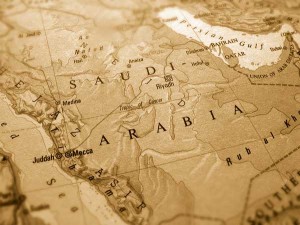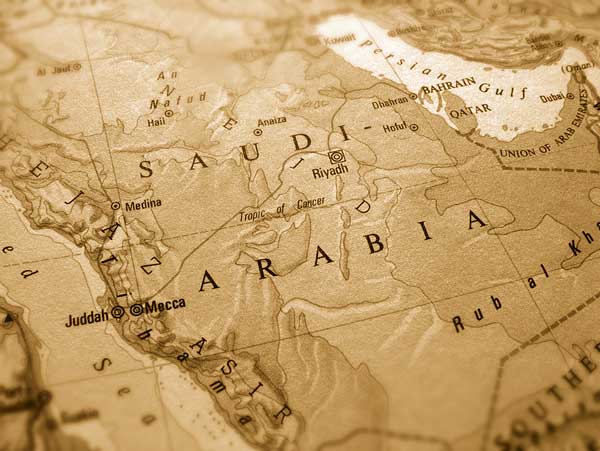
01/08/2011 – The U.S. Government’s Conventional Arms Transfer Policy requires that major sales advance U.S. national interests, are consistent with the recipient country’s legitimate security needs, and support U.S. regional security objectives. The sales to Saudi Arabia are widely supported within the U.S. government because they contribute to achieving these and other U.S. goals.
First, they enhance the Kingdom’s ability to defend itself against Iran. The new systems would strengthen the Saudi Arabian armed forces and thereby help balance and deter Iran’s growing military power. The new F-15s are an advance on the older ones. Of course, in modern defense, air assets are part of an overall defense capability and are not designed simply for air-to-air operations.
Even without Iran’s acquisition of nuclear weapons, the Iranian military has been displaying a growing range of conventional capabilities, showing off new missile, naval, and air capabilities as well as expanding the Iranian ground forces. In October, U.S. law enforcement agents exposed an Iranian plot to hire a professional hit man to assassinate the Saudi ambassador to the United States in a restaurant in downtown Washington.

Second, the weapons—and related sales to other Persian Gulf allies of the United States—can help protect the Gulf’s vital oil exports. Even now Iranians continue to threaten to close the Strait of Hormuz to disrupt its vital oil exports. On December 27, Mohammad-Reza Rahimi, Iran’s first vice president, warned that, “If they [Western Powers] impose sanctions on Iran’s oil exports, then even one drop of oil cannot flow from the Strait of Hormuz.” The following day, Iranian naval commander Rear Admiral Habibollah Sayyari stated that, “Iran has total control over the strategic waterway…Closing the Strait of Hormuz is very easy for Iranian naval forces.” The Iranian Navy was conducting a major maritime interdiction exercise in the Persian Gulf at the time these threats were made.
Iranians issue such threats to underscore Tehran’s capacity to exploit Western dependence on Persian Gulf energy supplies and to threaten the health of the global economy. Of course, such threats are seen by Arab states as also a threat to their own economic and security interests as well.
Even the most optimistic scenarios for the increased use of renewable energy still forecast continued Western dependence on Saudi Arabia’s petroleum exports for the international economy. Saudi Arabia, the world’s largest oil exporter, is the third-largest source of U.S. oil imports.
But as the Arctic supplies come on line and as the Russian role increases, the threat to oil supply might be greater to Arab States than to the West.
Such threats raise insurance costs to commercial shippers even if their vessels were not physically attacked. The threats remind the world that Tehran might not react passively to additional sanctions. Iranians might hope that Russia and China will press the EU and Japan to avoid adopting new sanctions on Iran’s oil exports. Making threats is useful to Tehran since they can raise world oil prices and therefore generate some additional Iranian export revenue. Iranian leaders might also like to show their people how tough they are in defending Iranian interests from foreign challenges.
The United States has been seeking to enhance missile defense capabilities throughout the Persian Gulf region by placing American-run, ground-based missile defense systems in several Gulf states, by stationing specially equipped U.S. Navy missile ships in the Gulf’s waters, and by selling several types of missile defense systems to Saudi Arabia and other members of the Gulf Cooperation Council (GCC). The systems sold to the GCC include both the low-altitude Patriot and the higher-altitude Terminal High Altitude Area Defense (THAAD) systems, which together provide a more comprehensive layered missile and air defense network than either system in isolation, especially when networked with the U.S.-operated missile-defense systems. Although imperfect, they contribute to protecting the GCC’s energy production and distribution infrastructure, including shielding the tankers conveying oil through the Gulf.
A key challenge will be to integrate air and ground or surface based missile defense assets, a core competence which the F-35 will address.
In this regard, the arms sales help regional allies contribute better to their own defense. The transferred weapons would ease the burden on the overstretched U.S. military and the overburdened American taxpayer of countering Iran. The Administration is in the process of making large arms sales to Iraq and the United Arab Emirates (UAE). For example, last month the UAE agreed to a multi-billion dollar deal to purchase Lockheed Martin’s THAAD interceptors. The UAE is also purchasing 4,900 U.S. guided-bomb kits, including 600 for bunker-buster munitions.
In this context, Saudi Arabia is a key local ally for Washington given the weakness of Iraq, Iran’s traditional rival, and the limited military potential of the other Gulf states. Fortifying the Saudi Arabian military with additional weapons would help achieve Washington’s regional security goals, especially balancing Iranian ambitions and containing Iranian aggression regarding other Persian Gulf states.
U.S. arms sales to America’s allies in the Persian Gulf promote defense interoperability, both among themselves and with U.S. forces. In recent years, the United States has been selling weapons to other Gulf states concerned about a potential power vacuum in the region or about Iran’s growing strength. The F-15SAs’ communications systems will enable U.S. Saudi pilots to operate effectively together in the same airspace. The recently signed sales package includes joint training of some 5,500 Saudi personnel through 2019.
The United Arab Emirates, Kuwait, and the other members of the GCC have been especially prolific buyers of U.S. weapons. Although the GCC presently lacks the coherence—having limited means of coordination, integration, and standardization—to contain Iran on its own, equipping all their members with U.S.-made weapons, and training them to use them, can bolster their capabilities, especially in partnership with the Pentagon. In some scenarios, U.S. troops might use some of these weapons as they rush to reinforce the region. Even for more limited engagements, having access to the data generated by Saudi Arabian missile defense radars and other sensors could prove useful for defending U.S. forces and other targets in the Gulf.
Another objective of the sales is to highlight Washington’s commitment to defend Saudi Arabia and the other U.S. allies in the Persian Gulf despite the end of the U.S. military presence in Iraq and the Pentagon’s difficulties in Afghanistan.
Some Saudis worry that a pro-Iranian faction could gain political influence in Baghdad, confronting Saudi Arabia with having a pair of Shiite governments in two of the most powerful countries of the Persian Gulf aligned against it.
Even if Baghdad remains independent of Tehran’s influence, Iraq will take years to develop the military power needed to again serve as a regional balancer of Iran, even if the Iraqi government wanted to perform this role. In this context, the arms sales to both Saudi Arabia and Iraq serve as a tangible reaffirmation to the Kingdom that the U.S. security umbrella remains valid. In his briefing in the sale to reporters, Andrew Shapiro, assistant secretary of state for political-military affairs, told reporters that, “This sale will send a strong message to countries in the region that the United States is committed to stability in the gulf and broader Middle East,”
Sustaining the United States as the Kingdom’s main foreign arms supplier is also an important goal for maintaining U.S. influence in Riyadh, which can encourage Saudi officials to continue to support policies favorable to U.S. interests, and the Middle East more generally. The F-15ASA platforms are expected to last for decades, encouraging close defense cooperation between Washington and Riyadh for a long time since Saudi Arabia will need access to U.S.-made spare parts, training, and upgrades for decades.
Several Saudi policies benefit the United States, including the Kingdom’s sponsorship of inter-faith dialogue, its domestic de-radicalization program, its restraining influence on the foreign policy of other Arab regimes, U.S.-Saudi intelligence cooperation against international terrorism, and Riyadh’s consistently moderate policies toward Israel.
There have been signs of tension between Washington and Riyadh in the last year over how much support to provide incumbent conservative governments in the Arab world confronted by mass uprisings. Saudi officials have been critical of Washington for not rendering greater support to pro-Western leaders of Bahrain, Egypt, and Yemen. They also would like the Obama administration to exert greater pressure on the Israeli government to curtail Jewish settlements in the West Bank and Gaza Strip. Meanwhile, the United States would like to sustain good general relations as the monarchy and other leadership posts pass from the current generation to their successors.
At least some Saudi officials have been reassured. An anonymous Saudi official told the New York Times that, “When you look at the size of this package, what does it tell you about U.S.-Saudi relations…It says it’s very strong and very solid. Any disagreements from time to time don’t affect the core relationship.”
(Editor’s Note: We will address the region’s response to the emergence of a nuclear Iran in the first issue of the Gray Swan Report to appear this month.)
The weapons sales also help recycle the petrodollars Saudi Arabia acquires from oil exports—as well as encouraging Saudi Arabia to work with American firms through offsets in developing their energy sector and other infrastructure.
A final argument in favor of the sale is that, if the United States declines to provide the Saudi government with adequate defensive weapons, then Riyadh would likely pursue other means of strengthening its security.
Most likely, Saudi officials, who have always sought multiple arms supply relationships as a hedge against a weakening of their ties with Washington, would buy the weapons from other suppliers. Saudi Arabia has already bought a number of European weapons in recent years, including multibillion-dollar contracts for the Eurofighter Typhoon fighter planes and a border security system from British-based firms, as well as some helicopters and artillery pieces from French suppliers.
The Kingdom could plausibly purchase more weapons from China, which sold Saudi Arabia some intermediate-range missiles in the 1980s. The Saudis might also buy Russian arms to provide an additional incentive to dissuade Moscow from selling more sophisticated weapons to Iran. Some of these purchases might not include the safeguards for Israel that accompany the F-15SA transaction.
It is possible, though unlikely, that the Saudi government might decide to conserve its resources and try to appease Tehran. Conversely, Riyadh might seek to acquire nuclear weapons as an ultimate deterrent. Whether Saudi Arabia relied on its emerging nuclear power program to manufacture weapons (which could take at least a decade without major foreign assistance) or simply bought ready-made atomic bombs from Pakistan or another country, Saudi Arabia’s acquisition of nuclear weapons would contribute to further nuclear proliferation in the Middle East, a development harmful to U.S. interests.
Two general objections have been raised to the sales. First, there is some worry that the Saudi government will use the weapons in ways the United States would not like. For example, the Saudi military might be called on to suppress popular uprisings in Bahrain, in other Arab countries, or even at home. But end user agreements require that Saudi Arabia seek U.S. government approval before they transfer the weapons to another country. And the core systems at issue are designed for conventional military defense against external attack and not suitable for crowd suppression.
There was also some initial concern by pro-Israeli groups about the sales. In November 2010, more than one hundred members of Congress wrote a letter expressing their concerns about the proposed transaction. Following some initial complaints however the government of Israel and its supporters in the United States have generally not opposed the proposed arms sales to Saudi Arabia.
One factor dampening Israeli concerns is that Saudi Arabia already possesses many of the proposed weapons systems, so the sale would not represent a major qualitative leap in Saudi military potential. Many would expand capabilities currently in limited supply, while others would complement Saudi Arabia’s existing panoply of American- and European-made weapons.
In addition, the United States has reportedly agreed not to outfit the weapons platforms provided to Saudi Arabia with the most advanced capabilities suitable for attacking Israel, such as long-range stand-off weapons. Instead, they will be equipped with the more modest armaments the United States normally sells with export versions of these warplanes. For example, the AGM-84 Harpoon Block II missile the Saudis will receive does not include the Block III data link package for in-flight retargeting.
The decision to provide the Saudis with more F-15s is itself a means to reassure Israel, since the planes are inferior to what Israel will possess but is superior to the warplanes Iran possesses. Due to various international sanctions, Iran’s military aviation wing has become very weak. Iran has instead chosen to invest in ballistic and cruise missiles with possible chemical, biological, or most likely nuclear warheads.
The United States has agreed to sell Israel even more advanced weapons to help sustain its military superiority. In particular, Lockheed Martin will provide the new U.S. F-35 stealth fighters to Israel around 2015, about the same time that Boeing supplies Saudi Arabia with the F-15SAs.
Furthermore, unlike during the 1980s and 1990s, many Israeli strategists now consider Iran, rather than the Arab countries, as presenting the greatest external threat to Israel’s security. And the new weapons the United States is providing Saudi Arabia and other Arab countries in the Persian Gulf would help contain Iranians’ growing military power and regional security ambitions.
The other general set of objections relate to general unease that the Saudi monarchy might not last as long as the planes. The Arab Spring has reminded everyone of the lesson of the 1978-79 Iranian Revolution – how rapidly even long-standing regimes can change. The weapons we sell today can potentially be used against us tomorrow. Some might worry that, by spending so much on weapons, the Saudi leaders are making the same mistake as the Shah in neglecting popular welfare in favor of military might.
This argument is harder to refute since the nature of regime change is complex. The relationship between military spending and popular revolutions is probably much weaker than many other types of causal links that explain revolutionary upheaval. And one hopes that Boeing and its partners will structure the sale so that the Saudis will need to continue to rely on U.S. supplies and assistance no matter who rules in Riyadh.
(Editor’s Note: We will address the region’s response to the emergence of a nuclear Iran in the first issue of the Gray Swan Report to appear this month.)


